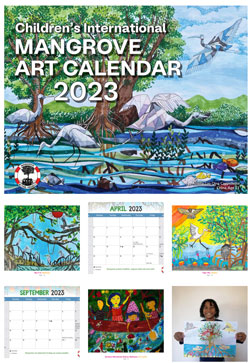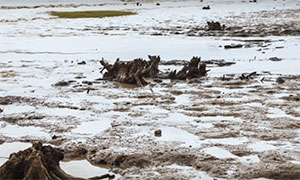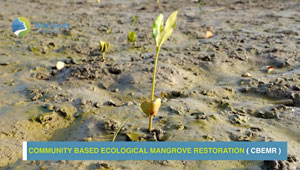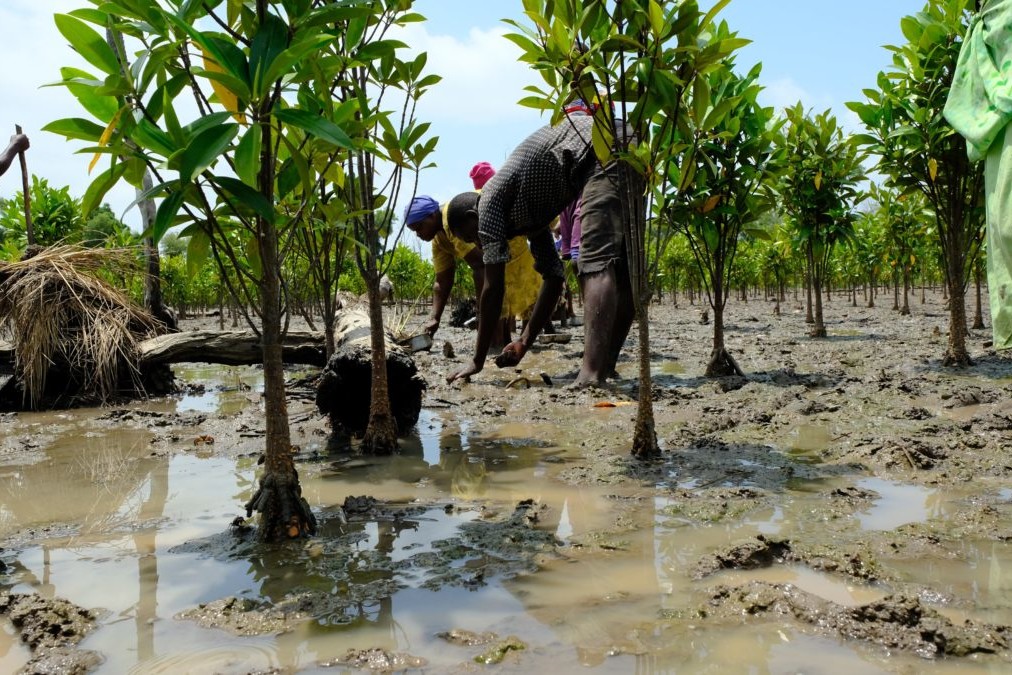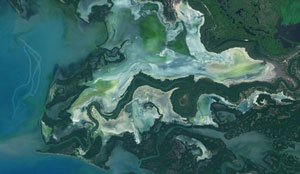The MAP News
|
|
|
FEATURE STORY
Open letter to the people of The Netherlands, from the environmentally endangered Maldives  MALDIVES - New Year’s greetings from the Maldives. You may have heard about our country: an earthly “paradise” that is home to luxury tourism. That’s the marketed image, representing a “sunny side of life”. We also have several, less sunny stories. This particular one is about the endangered and finite ecosystems of the Maldives that have an unhappy connection to your country, the Netherlands. As the new year breaks in 2023, the news breaking in the Maldives is that two of the most damaging marine contractors from the Netherlands will be actively destroying critical marine ecosystems with unknown losses and damage to communities and people in the Maldives. Van Oord is planning to dredge Addu Atoll Biosphere Reserve, endangering multiple MPAs, marine habitats of mega-fauna such as manta rays and undermining the climate resilience of the entire atoll. Royal Boskalis will be preparing to destroy Gulhifalhu reef and lagoon. These are the untold stories of Maldives on the frontline of the global climate crisis. As we become increasingly conscious of our interconnectedness on earth, it is necessary to tell the story of how one nation’s business enterprise has become another’s destruction and demise. MALDIVES - New Year’s greetings from the Maldives. You may have heard about our country: an earthly “paradise” that is home to luxury tourism. That’s the marketed image, representing a “sunny side of life”. We also have several, less sunny stories. This particular one is about the endangered and finite ecosystems of the Maldives that have an unhappy connection to your country, the Netherlands. As the new year breaks in 2023, the news breaking in the Maldives is that two of the most damaging marine contractors from the Netherlands will be actively destroying critical marine ecosystems with unknown losses and damage to communities and people in the Maldives. Van Oord is planning to dredge Addu Atoll Biosphere Reserve, endangering multiple MPAs, marine habitats of mega-fauna such as manta rays and undermining the climate resilience of the entire atoll. Royal Boskalis will be preparing to destroy Gulhifalhu reef and lagoon. These are the untold stories of Maldives on the frontline of the global climate crisis. As we become increasingly conscious of our interconnectedness on earth, it is necessary to tell the story of how one nation’s business enterprise has become another’s destruction and demise.AFRICAForum On Co-Management of Mangroves for Women Shell-Fishers Held GAMBIA - Try Oyster' association together with the University of Cape Coast in Ghana; Development Action Association (DAA ); World Agroforestry (ICRAF) and the University of Rhode Island (URI ), recently held a day-long forum at a hotel in Bijilo, on mangrove co-management for women shell fishers and food security projects. During the course of the activity, facilitators in collaboration with partners, shared their findings from a two-year study on mangrove restoration. Coordinators revealed that all the mangrove plantations they visited from Bullock to Tanbi and other national wetlands with an area of 6,000 hectares, are the most affected mangrove wetland which threatens marine biodiversity. A ten year vision was developed with an upgrading strategy and implementation plan for value chain upgrading activities which acknowledges the need to take action to ensure that the mangroves oyster value chain is resilient and meets a growing demand for nutritious, safe and affordable food while maintaining sustainable ecosystems, economies and societies that leaves no one behind. GAMBIA - Try Oyster' association together with the University of Cape Coast in Ghana; Development Action Association (DAA ); World Agroforestry (ICRAF) and the University of Rhode Island (URI ), recently held a day-long forum at a hotel in Bijilo, on mangrove co-management for women shell fishers and food security projects. During the course of the activity, facilitators in collaboration with partners, shared their findings from a two-year study on mangrove restoration. Coordinators revealed that all the mangrove plantations they visited from Bullock to Tanbi and other national wetlands with an area of 6,000 hectares, are the most affected mangrove wetland which threatens marine biodiversity. A ten year vision was developed with an upgrading strategy and implementation plan for value chain upgrading activities which acknowledges the need to take action to ensure that the mangroves oyster value chain is resilient and meets a growing demand for nutritious, safe and affordable food while maintaining sustainable ecosystems, economies and societies that leaves no one behind.It’ll take 150 years to map Africa’s biodiversity at the current rate.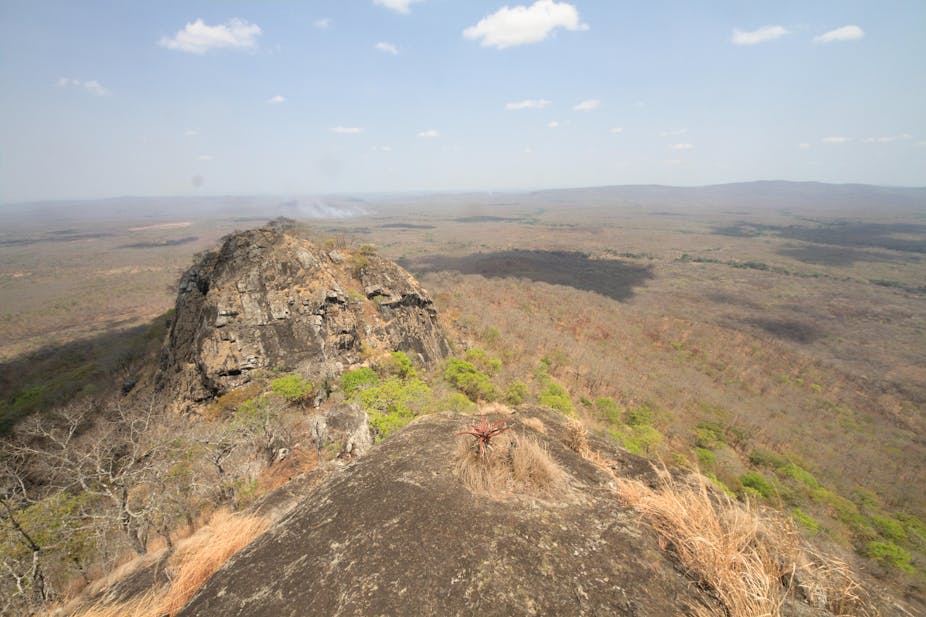 AFRICA - Africa’s biomes extend from mangroves to deserts, from Mediterranean to tropical forests, from temperate to sub-tropical and montane grasslands and savannas, and even to ice-capped mountains. About a quarter of the world’s species of plants and animals are found on the continent. But biodiversity isn’t just beautiful. We need it to survive. Different species and biomes provide ecosystem services to humans: food, clothing, potable water and the very air we breathe. The disappearance of a seemingly unimportant animal, like a certain species of bee, may result in the extinction of certain plant species. That, in turn, affects humans and other species.Experts have estimated that each country, globally, must protect the biodiversity of 30% of its territory by 2030 to at least mitigate the effects of ongoing environmental damage. But we found in a recent study that huge swathes of Africa remain unstudied and their species undocumented. Why? Because scientists keep returning to areas whose biodiversity has already been mapped, rather than visiting new, unexplored areas. AFRICA - Africa’s biomes extend from mangroves to deserts, from Mediterranean to tropical forests, from temperate to sub-tropical and montane grasslands and savannas, and even to ice-capped mountains. About a quarter of the world’s species of plants and animals are found on the continent. But biodiversity isn’t just beautiful. We need it to survive. Different species and biomes provide ecosystem services to humans: food, clothing, potable water and the very air we breathe. The disappearance of a seemingly unimportant animal, like a certain species of bee, may result in the extinction of certain plant species. That, in turn, affects humans and other species.Experts have estimated that each country, globally, must protect the biodiversity of 30% of its territory by 2030 to at least mitigate the effects of ongoing environmental damage. But we found in a recent study that huge swathes of Africa remain unstudied and their species undocumented. Why? Because scientists keep returning to areas whose biodiversity has already been mapped, rather than visiting new, unexplored areas.AMERICANew Teaching Website Launched by Mangrove Education Project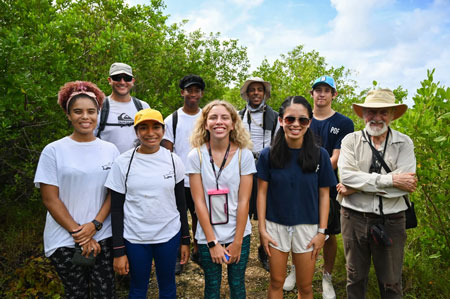 CAYMAN ISLANDS -The Cayman Islands-based environmental education NPO, the Mangrove Education Project (MEP), will be launching a new education website to cover the entire Coastal Lagoon ecosystem later this month.The site has been developed to support the Coastal Lagoon Ecosystem Teachers Guide which provides in-depth teaching resources for Cayman teachers. Its vision is to bring a deep understanding of the of true value of this dynamic ecosystem and our interdependence on it.“The goal is to Introduce students, teachers, parents and their communities to the wonderful world of the tropical lagoon coastline through a curriculum-based, hands-on science program,” explains MEP executive director, Martin Keeley. “It links exciting and fun-filled ecological exploration with a deep understanding of the importance and intricacies of this wonderful ecosystem throughout the Caribbean and world-wide.” CAYMAN ISLANDS -The Cayman Islands-based environmental education NPO, the Mangrove Education Project (MEP), will be launching a new education website to cover the entire Coastal Lagoon ecosystem later this month.The site has been developed to support the Coastal Lagoon Ecosystem Teachers Guide which provides in-depth teaching resources for Cayman teachers. Its vision is to bring a deep understanding of the of true value of this dynamic ecosystem and our interdependence on it.“The goal is to Introduce students, teachers, parents and their communities to the wonderful world of the tropical lagoon coastline through a curriculum-based, hands-on science program,” explains MEP executive director, Martin Keeley. “It links exciting and fun-filled ecological exploration with a deep understanding of the importance and intricacies of this wonderful ecosystem throughout the Caribbean and world-wide.”
Protecting the Amazon Biodiversity Through ‘Mothers of the Mangrove’
.jpg) BRAZIL - Mangroves are valuable ecosystems and marine life nurseries essential for artisanal fishing, culture, and community-based tourism. In Pará, Brazil, Extractive Reserves (RESEX) are sustainable use protected areas where only local people have the right to traditional hunting, fishing, and harvesting wild plants. Yet, despite the territory's abundance, families struggle financially, and women are undervalued as nature’s caregivers and holders of traditional wisdom. The role of women in Amazonia must be amplified, and they must be empowered to defend mangroves. This project will support Mothers of the Mangrove, empowering 36 women leaders in the Amazon coastal zone and spreading their conservation skills and sustainable use practices. Partnering with the environmental organization Rare, they will be able to further their protection network of the Amazonian mangroves and expand upon new income-generating businesses that work in harmony with nature. The project aims to help Mothers of the Mangrove reach 900 community members to protect 167,705 hectares of mangrove forest through sustainable use practices, promoting their ancestry and traditional knowledge. This includes the second edition of a book featuring their business, network, and management of the RESEX. It will also create access to savings clubs. BRAZIL - Mangroves are valuable ecosystems and marine life nurseries essential for artisanal fishing, culture, and community-based tourism. In Pará, Brazil, Extractive Reserves (RESEX) are sustainable use protected areas where only local people have the right to traditional hunting, fishing, and harvesting wild plants. Yet, despite the territory's abundance, families struggle financially, and women are undervalued as nature’s caregivers and holders of traditional wisdom. The role of women in Amazonia must be amplified, and they must be empowered to defend mangroves. This project will support Mothers of the Mangrove, empowering 36 women leaders in the Amazon coastal zone and spreading their conservation skills and sustainable use practices. Partnering with the environmental organization Rare, they will be able to further their protection network of the Amazonian mangroves and expand upon new income-generating businesses that work in harmony with nature. The project aims to help Mothers of the Mangrove reach 900 community members to protect 167,705 hectares of mangrove forest through sustainable use practices, promoting their ancestry and traditional knowledge. This includes the second edition of a book featuring their business, network, and management of the RESEX. It will also create access to savings clubs.ASIA Fishers on Indonesia’s Batam Island suffer as mangrove cover declines  INDONESIA - “There’s no more fish,” says Abdul Ganip, holding up a mostly empty flask containing a few prawns. “It’s a quiet catch.” For decades, the 57-year-old has lived and worked as a fisherman on the Indonesian island of Batam, better known as an industrial hub and special economic zone off the eastern coast of Sumatra. He and other fishermen eked out a profit catching and selling seafood on this 715-square-kilometer (276-square-mile) island, where the mangrove habitat accounted for only 4% of the landmass as of 1990. Similar to Singapore, less than an hour by ferry to the north, the rest of Batam is paved over and even expanded with infill, the reclamation of coastal and brackish areas with sand to create new land for factories, resorts and apartment blocks. In 2015, geographers from Indonesia’s Gadjah Mada University published an analysis of satellite data showing there had been some natural attrition in Batam’s mangrove habitat from 1990 to 2000 due to erosion from “wind, waves and flooding.” However, the overwhelming cause of habitat degradation — 96% — was human development. INDONESIA - “There’s no more fish,” says Abdul Ganip, holding up a mostly empty flask containing a few prawns. “It’s a quiet catch.” For decades, the 57-year-old has lived and worked as a fisherman on the Indonesian island of Batam, better known as an industrial hub and special economic zone off the eastern coast of Sumatra. He and other fishermen eked out a profit catching and selling seafood on this 715-square-kilometer (276-square-mile) island, where the mangrove habitat accounted for only 4% of the landmass as of 1990. Similar to Singapore, less than an hour by ferry to the north, the rest of Batam is paved over and even expanded with infill, the reclamation of coastal and brackish areas with sand to create new land for factories, resorts and apartment blocks. In 2015, geographers from Indonesia’s Gadjah Mada University published an analysis of satellite data showing there had been some natural attrition in Batam’s mangrove habitat from 1990 to 2000 due to erosion from “wind, waves and flooding.” However, the overwhelming cause of habitat degradation — 96% — was human development.Govt to push seagrass, mangrove preservation to boost blue carbo
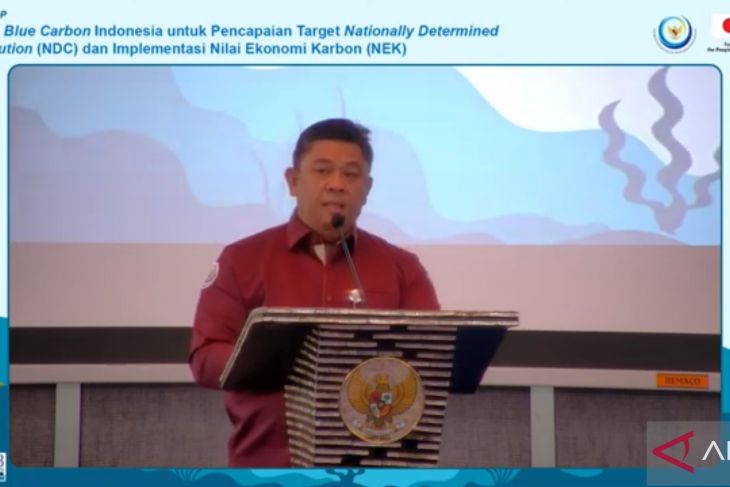 INDONESIA - The Maritime Affairs and Fisheries (KKP) Ministry will step up efforts to conserve seagrass and mangroves as part of the government’s strategy to tackle climate change and improve blue carbon potential. "(The development of) Indonesia's other blue carbon ecosystem (apart from mangroves), namely seagrasses, which has (cover) an estimated area of 1.8 million hectares, has not received much attention so far," director general of sea spatial management of the ministry Victor Gustaaf Manoppo observed. He made the statement during a workshop on the “Blue Carbon Strategy for Achieving Nationally Determined Contributions (NDC) Targets and Implementation of Carbon Economic Values (NEK)” on Tuesday. The seagrass ecosystem in Indonesia can absorb up to 790 million tons of carbon dioxide (CO2), with a projected economic value of US$35 billion, he informed. Meanwhile, Indonesia's mangrove ecosystem, which covers an area of around 3.36 million hectares, is expected to absorb 11 billion tons of CO2 with an estimated economic value of US$66 billion. INDONESIA - The Maritime Affairs and Fisheries (KKP) Ministry will step up efforts to conserve seagrass and mangroves as part of the government’s strategy to tackle climate change and improve blue carbon potential. "(The development of) Indonesia's other blue carbon ecosystem (apart from mangroves), namely seagrasses, which has (cover) an estimated area of 1.8 million hectares, has not received much attention so far," director general of sea spatial management of the ministry Victor Gustaaf Manoppo observed. He made the statement during a workshop on the “Blue Carbon Strategy for Achieving Nationally Determined Contributions (NDC) Targets and Implementation of Carbon Economic Values (NEK)” on Tuesday. The seagrass ecosystem in Indonesia can absorb up to 790 million tons of carbon dioxide (CO2), with a projected economic value of US$35 billion, he informed. Meanwhile, Indonesia's mangrove ecosystem, which covers an area of around 3.36 million hectares, is expected to absorb 11 billion tons of CO2 with an estimated economic value of US$66 billion.OCEANA The magic of mangrove
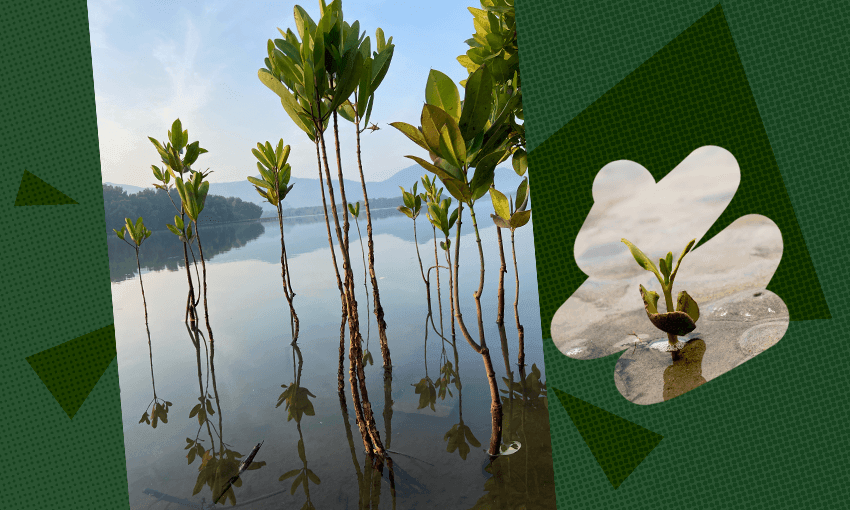 NEW-ZEALAND - In the northern part of Aotearoa, mangroves occupy mudflats and river mouths. They’re not always loved – but given our rising sea level, maybe they should be. It took a long time for Mere Kepa (Ngati Raka, Ngati Ira) to learn to love the manawa. She grew up around their forests, glossy green leaves lining the harbour around her father’s kainga. But when she was a child, these mangrove forests weren’t appreciated. “Previous generations treated the mudflats like a rubbish dump,” she says. Kepa, a landowner in Takahiwai near Whangārei, only started paying attention to the mangroves when she was putting together a pest control strategy for her community to reduce the number of feral pigs on their land. That required thinking about the different habitats around her, including the mangrove forests bordering the estuaries. “I became friendlier with the manawa,” she says. “They take up a lot of the sunshine in Whangārei harbour – you can’t miss them.” NEW-ZEALAND - In the northern part of Aotearoa, mangroves occupy mudflats and river mouths. They’re not always loved – but given our rising sea level, maybe they should be. It took a long time for Mere Kepa (Ngati Raka, Ngati Ira) to learn to love the manawa. She grew up around their forests, glossy green leaves lining the harbour around her father’s kainga. But when she was a child, these mangrove forests weren’t appreciated. “Previous generations treated the mudflats like a rubbish dump,” she says. Kepa, a landowner in Takahiwai near Whangārei, only started paying attention to the mangroves when she was putting together a pest control strategy for her community to reduce the number of feral pigs on their land. That required thinking about the different habitats around her, including the mangrove forests bordering the estuaries. “I became friendlier with the manawa,” she says. “They take up a lot of the sunshine in Whangārei harbour – you can’t miss them.”This tsunami-blocking coastal city draws inspiration from the shape of mangrove roots 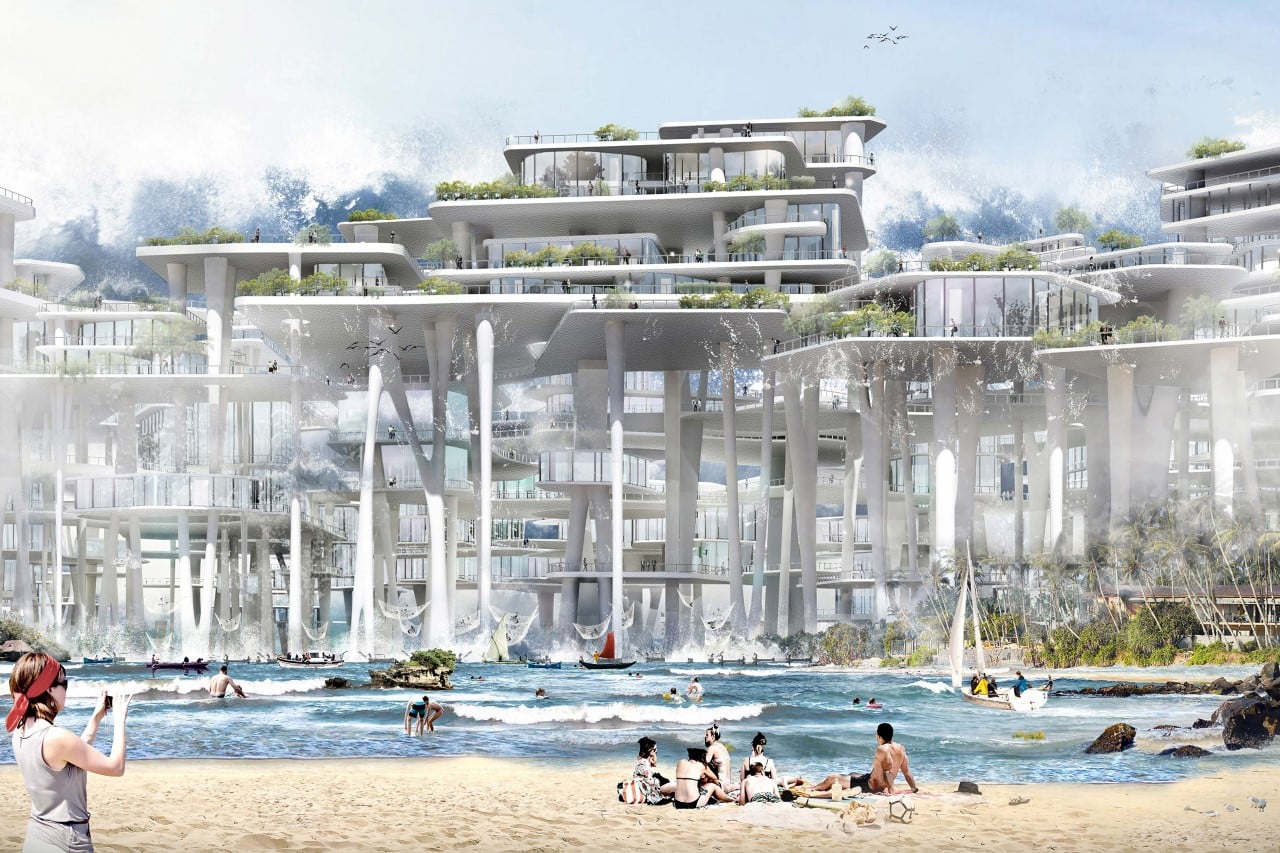 TONGA - The volcanic eruption of Tonga on the 14th of January in 2022 created a major tsunami hazard for the entire pacific rim. The pacific rim is said to be the most prone to tsunamis, given its connection to all four major tectonic plates. It’s only natural for the architecture of the area to evolve to match this unique threat, and that’s what the Tsunami Park Skyscraper aims at doing. This eVolo Skyscraper Award-winning architectural design models itself on the shape and layout of mangrove roots that help break waves and currents by almost instantly slowing down water currents to help distribute their impact. “Mangroves are woody plant communities in the intertidal zone of tropical and subtropical coasts, with developed root systems and staggering growth, which have the best effect on tsunami mitigation”, mention the designers. “Therefore, the skyscraper is inspired by the principle and mechanism of mangrove resistance to tsunamis, and consists of a single unit aggregated to form a vast complex along the coastline. Each cell consists of a bottom pillar and a top multi-level platform. The bottom pillar is made up of thick concrete columns that form a porous structure to dissipate the enormous force of the tsunami, while the upper platforms are of varying sizes, heights, and interconnections to carry people’s lives. TONGA - The volcanic eruption of Tonga on the 14th of January in 2022 created a major tsunami hazard for the entire pacific rim. The pacific rim is said to be the most prone to tsunamis, given its connection to all four major tectonic plates. It’s only natural for the architecture of the area to evolve to match this unique threat, and that’s what the Tsunami Park Skyscraper aims at doing. This eVolo Skyscraper Award-winning architectural design models itself on the shape and layout of mangrove roots that help break waves and currents by almost instantly slowing down water currents to help distribute their impact. “Mangroves are woody plant communities in the intertidal zone of tropical and subtropical coasts, with developed root systems and staggering growth, which have the best effect on tsunami mitigation”, mention the designers. “Therefore, the skyscraper is inspired by the principle and mechanism of mangrove resistance to tsunamis, and consists of a single unit aggregated to form a vast complex along the coastline. Each cell consists of a bottom pillar and a top multi-level platform. The bottom pillar is made up of thick concrete columns that form a porous structure to dissipate the enormous force of the tsunami, while the upper platforms are of varying sizes, heights, and interconnections to carry people’s lives.
*Articles in this newsletter may mention practices being used and/or show exagerated results being claimed without proof. Stories are presented here in effort to show mangrove related activity around the world and do not necessarily reflect Mangrove Action Project's views or mangrove restoration best-practices. NOTICEChildrens Art Calendars 2023
ORDER YOURS HERE
ACTION ALERTS
|
|
|
Mangrove Action Project Click here to view past newsletters
|
|
Search News Archive
Saturday, January 28, 2023
MAP ISSUE #564 - Jan 28, 2023
Saturday, January 14, 2023
MAP Issue #563 - Jan 14, 2023
The MAP News
|
|
|
FEATURE STORY
The struggle to save the last mermaids of Africa /cloudfront-eu-central-1.images.arcpublishing.com/prisa/IBCPQVJXMNEBDM4U2C2CEDU3UE.jpg) SENEGAL - “We, the Diola, cannot catch them. It is forbidden. To catch one you must have mystical powers,” says Louis Diatta, sitting on the banks of the Casamance River, scanning the surface of the water and talking about the West African manatees as if they were people. “They are like us,” he says. “The females have breasts and suckle their babies. They move as a family. Instead of arms and legs, they have fins, but when you look into their eyes, you get a surprise. It’s as if they were half human.” The Pointe de Saint George is one of the few places in Senegal where you can observe West African manatees, an endangered species shrouded in mystery. If you’re lucky, that is, because, like all legendary beings, they are shy and elusive. The road to this place is as magical as the manatees themselves. A nine-kilometer path that links this village to the rest of the world takes you through huge flamboyant trees and baobabs, rice fields and mangroves. SENEGAL - “We, the Diola, cannot catch them. It is forbidden. To catch one you must have mystical powers,” says Louis Diatta, sitting on the banks of the Casamance River, scanning the surface of the water and talking about the West African manatees as if they were people. “They are like us,” he says. “The females have breasts and suckle their babies. They move as a family. Instead of arms and legs, they have fins, but when you look into their eyes, you get a surprise. It’s as if they were half human.” The Pointe de Saint George is one of the few places in Senegal where you can observe West African manatees, an endangered species shrouded in mystery. If you’re lucky, that is, because, like all legendary beings, they are shy and elusive. The road to this place is as magical as the manatees themselves. A nine-kilometer path that links this village to the rest of the world takes you through huge flamboyant trees and baobabs, rice fields and mangroves.GLOBALYou don’t want to know where your shrimp comes from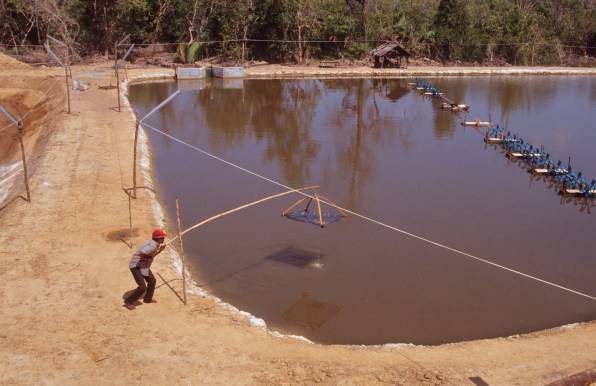 GLOBAL - If you rang in the new year with some shrimp cocktail in hand, you weren’t alone. Shrimp is the most popular seafood among Americans, with industry groups reporting that we eat about five pounds of shrimp each year, per person. We hear a lot about the negative effects of industrial animal agriculture on our planet, not to mention the animal cruelty inherent in it— but these conversations are almost invariably focused on land animals raised as livestock, particularly cows and chickens. If seafood seems to have an eco-friendly halo by contrast, that’s probably more due to our own educational blind spots than any true environmental superiority. Despite their small size, shrimp carry some major ethical baggage that includes the destruction of critical environmental features as well as horrific human rights abuses and chilling acts of animal cruelty. GLOBAL - If you rang in the new year with some shrimp cocktail in hand, you weren’t alone. Shrimp is the most popular seafood among Americans, with industry groups reporting that we eat about five pounds of shrimp each year, per person. We hear a lot about the negative effects of industrial animal agriculture on our planet, not to mention the animal cruelty inherent in it— but these conversations are almost invariably focused on land animals raised as livestock, particularly cows and chickens. If seafood seems to have an eco-friendly halo by contrast, that’s probably more due to our own educational blind spots than any true environmental superiority. Despite their small size, shrimp carry some major ethical baggage that includes the destruction of critical environmental features as well as horrific human rights abuses and chilling acts of animal cruelty.AFRICAFirst study to estimate 'blue carbon' storage in South Africa is useful for climate strategy SOUTH AFRICA - Marine ecosystems have a valuable role to play in mitigating the effects of climate change. That’s because such ecosystems – and, particularly, vegetated tidal ecosystems like mangroves and salt marshes – capture and store a significant amount of atmospheric carbon dioxide (CO₂). CO₂ has accumulated in Earth’s atmosphere at unprecedented levels since the industrial revolution. Scientific evidence shows this is the primary driver of climate change. “Blue carbon”, the term used to describe CO₂ absorbed by marine ecosystems, was an important topic of discussion at last year’s COP27 talks in Egypt. More countries are bringing blue carbon into their climate change plans and policies. Indonesia, for example, has made climate adaptation and mitigation efforts that focus on blue carbon a key component for achieving its Nationally Determined Contributions target by 2030. SOUTH AFRICA - Marine ecosystems have a valuable role to play in mitigating the effects of climate change. That’s because such ecosystems – and, particularly, vegetated tidal ecosystems like mangroves and salt marshes – capture and store a significant amount of atmospheric carbon dioxide (CO₂). CO₂ has accumulated in Earth’s atmosphere at unprecedented levels since the industrial revolution. Scientific evidence shows this is the primary driver of climate change. “Blue carbon”, the term used to describe CO₂ absorbed by marine ecosystems, was an important topic of discussion at last year’s COP27 talks in Egypt. More countries are bringing blue carbon into their climate change plans and policies. Indonesia, for example, has made climate adaptation and mitigation efforts that focus on blue carbon a key component for achieving its Nationally Determined Contributions target by 2030.AMERICASFlorida reverses course, fines Aqua development’s mangrove trimming on Sarasota Bay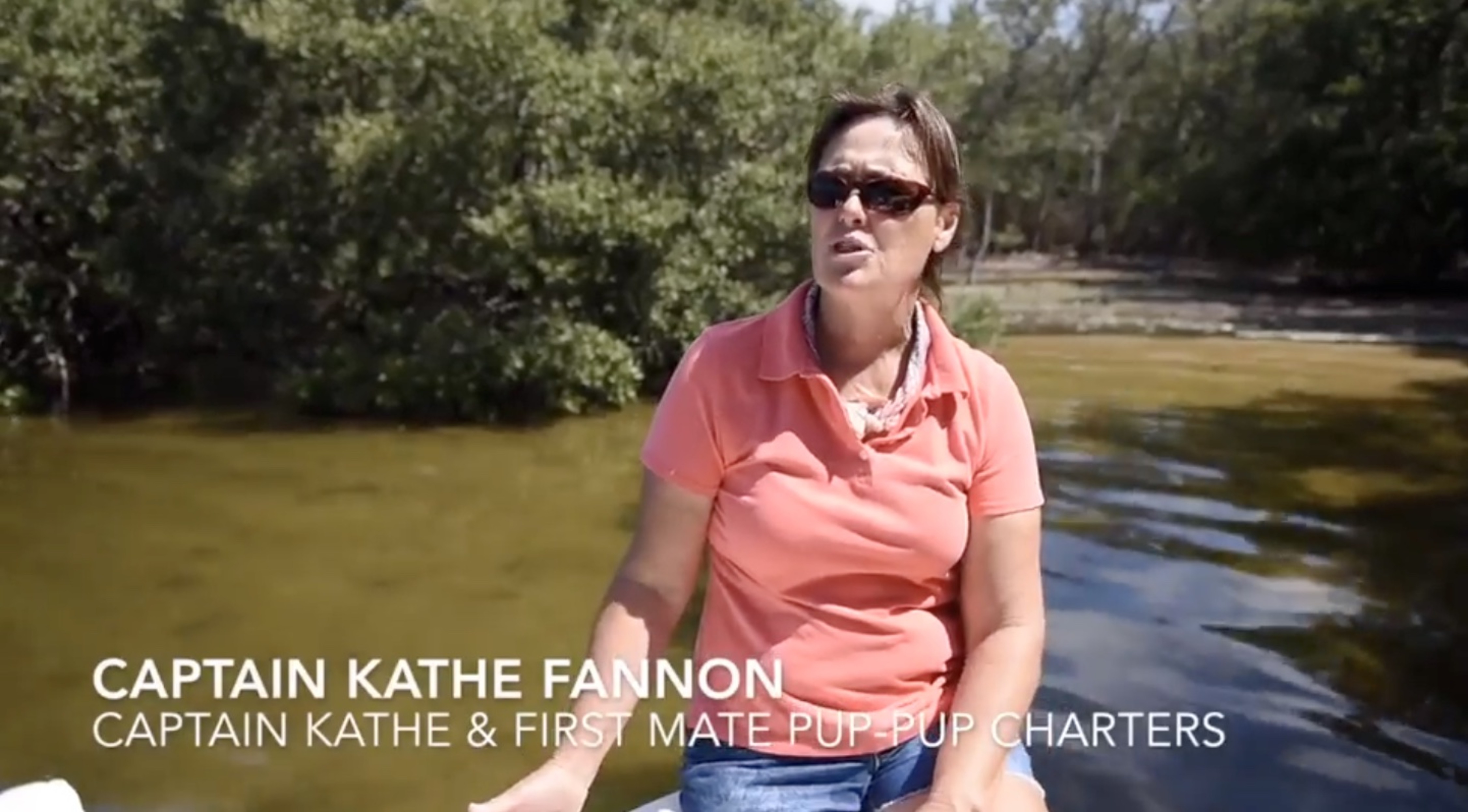 USA - The owners of the Aqua by the Bay development in southwest Manatee County have been hit with an $8,500 fine for illegal mangrove trimming. In a Dec. 22 consent order obtained by the Bradenton Herald, state officials with the Florida Department of Environmental Protection said the fine served as punishment for improper mangrove pruning. The fine marks a reversal for FDEP officials, who wrote after an initial inspection last summer that, “the mangroves appeared to be healthy and trimmed within the permit limits,” and described the damage as “minor non-compliance.”The Herald previously reported on concerns raised by local environmental activists about the trimming, which appeared to cut mangroves beyond what is allowed by state law. The trimming also left dead branches in the water, which can fuel harmful algae blooms as they decompose. USA - The owners of the Aqua by the Bay development in southwest Manatee County have been hit with an $8,500 fine for illegal mangrove trimming. In a Dec. 22 consent order obtained by the Bradenton Herald, state officials with the Florida Department of Environmental Protection said the fine served as punishment for improper mangrove pruning. The fine marks a reversal for FDEP officials, who wrote after an initial inspection last summer that, “the mangroves appeared to be healthy and trimmed within the permit limits,” and described the damage as “minor non-compliance.”The Herald previously reported on concerns raised by local environmental activists about the trimming, which appeared to cut mangroves beyond what is allowed by state law. The trimming also left dead branches in the water, which can fuel harmful algae blooms as they decompose.Indigenous community in southern Mexico revives mangroves  MEXICO - Members of an Ikoots indigenous community in the southern Mexican state of Oaxaca have embarked on a projects to restore the ravaged mangroves on the lake surrounding the village of San Mateo del Mar in hopes of mitigating the effects of climate change. Every evening at sundown, more than 70 women and men push carts loaded with soil and botoncillo (buttonwood) saplings down to the edge of the lake, which lies near the Gulf of Tehuantepec, for planting. The Ikoots are using the ancient Mesoamerican technique of “chinampas,” artificial islands created by interweaving reeds with stakes beneath the lake’s surface. The “floating gardens” of the Aztec capital of Tenochtitlan that made such an impression on the conquistadors are the best known examples of the practice. Doña Albertina Flores, a 45-year-old fisherwoman who works on the project along with her two children, takes a moment to tell EFE that restoring the mangroves will encourage the return of fish and shrimp, which were once plentiful in the lagoon. In many cases, she said, it was necessity that drove residents to chop down the mangroves. “But right now we are planting to help those little ones who are coming along,” Flores said. MEXICO - Members of an Ikoots indigenous community in the southern Mexican state of Oaxaca have embarked on a projects to restore the ravaged mangroves on the lake surrounding the village of San Mateo del Mar in hopes of mitigating the effects of climate change. Every evening at sundown, more than 70 women and men push carts loaded with soil and botoncillo (buttonwood) saplings down to the edge of the lake, which lies near the Gulf of Tehuantepec, for planting. The Ikoots are using the ancient Mesoamerican technique of “chinampas,” artificial islands created by interweaving reeds with stakes beneath the lake’s surface. The “floating gardens” of the Aztec capital of Tenochtitlan that made such an impression on the conquistadors are the best known examples of the practice. Doña Albertina Flores, a 45-year-old fisherwoman who works on the project along with her two children, takes a moment to tell EFE that restoring the mangroves will encourage the return of fish and shrimp, which were once plentiful in the lagoon. In many cases, she said, it was necessity that drove residents to chop down the mangroves. “But right now we are planting to help those little ones who are coming along,” Flores said.ASIAVital Northern Mangroves Need Uncompromising Protection
 SRI LANKA - On the northern coast of Sri Lanka in the Mannar District is a place of extraordinary importance to conservation and to the economic wellbeing of the human populations who have lived off its bounty for centuries. Vidattaltivu (Wedithalathive) is an amazing complex of interconnected ecosystems; it drives every activity there and beyond. The ecosystems of Vidattaltivu – sea grasses, mangroves, mud flats and salt marshes – are all vital for the diversity of the species they support. In 2009, at the end of the civil war, a Northern Strategic Environmental Assessment was inaugurated that looked at all the sensitive areas that had now been opened in the North. After five years of study, a comprehensive report was published that concluded due to its importance to biodiversity and people, Vidattaltivu be designated as a Protected Area. In 2016, it was declared a Nature Reserve by Extraordinary Gazette (No. 1956/13). Yet just one year later, in 2017, a joint paper was presented to the cabinet by the Ministry of Wildlife and Ministry of Forests to de-gazette Vidattaltivu. SRI LANKA - On the northern coast of Sri Lanka in the Mannar District is a place of extraordinary importance to conservation and to the economic wellbeing of the human populations who have lived off its bounty for centuries. Vidattaltivu (Wedithalathive) is an amazing complex of interconnected ecosystems; it drives every activity there and beyond. The ecosystems of Vidattaltivu – sea grasses, mangroves, mud flats and salt marshes – are all vital for the diversity of the species they support. In 2009, at the end of the civil war, a Northern Strategic Environmental Assessment was inaugurated that looked at all the sensitive areas that had now been opened in the North. After five years of study, a comprehensive report was published that concluded due to its importance to biodiversity and people, Vidattaltivu be designated as a Protected Area. In 2016, it was declared a Nature Reserve by Extraordinary Gazette (No. 1956/13). Yet just one year later, in 2017, a joint paper was presented to the cabinet by the Ministry of Wildlife and Ministry of Forests to de-gazette Vidattaltivu.Indonesia’s ‘essential’ mangroves, seagrass and corals remain unprotected  INDONESIA - Much of the mangroves, seagrass beds and coral reefs in Indonesia lie outside protected areas, which could thwart efforts at effective marine conservation, a new report shows. “These essential ecosystems, i.e. mangrove, seagrass, coral reef — the power of three, are known as ecosystems that function as habitat and protection for sea organisms, fish, including for nursery ground/reproduction,” Tezza Napitupulu, a former economics researcher at WRI Indonesia and lead author of the report published earlier this month. With the threat of the climate crisis, there’s been a growing appreciate of these ecosystems’ importance as barriers against ocean disasters and as stores of carbon dioxide, especially mangroves and seagrass, said Napitupulu, who is now a lecturer at the University of Indonesia’s School of Economics and Business. “We’re calling for more of these essential ecosystems to be included in the marine protected areas in the future,” said Arief Wijaya, WRI Indonesia’s program director and a co-author of the report. INDONESIA - Much of the mangroves, seagrass beds and coral reefs in Indonesia lie outside protected areas, which could thwart efforts at effective marine conservation, a new report shows. “These essential ecosystems, i.e. mangrove, seagrass, coral reef — the power of three, are known as ecosystems that function as habitat and protection for sea organisms, fish, including for nursery ground/reproduction,” Tezza Napitupulu, a former economics researcher at WRI Indonesia and lead author of the report published earlier this month. With the threat of the climate crisis, there’s been a growing appreciate of these ecosystems’ importance as barriers against ocean disasters and as stores of carbon dioxide, especially mangroves and seagrass, said Napitupulu, who is now a lecturer at the University of Indonesia’s School of Economics and Business. “We’re calling for more of these essential ecosystems to be included in the marine protected areas in the future,” said Arief Wijaya, WRI Indonesia’s program director and a co-author of the report.
Mangrove Clearance Halt Progress On Virar-Dahanu Railway Line
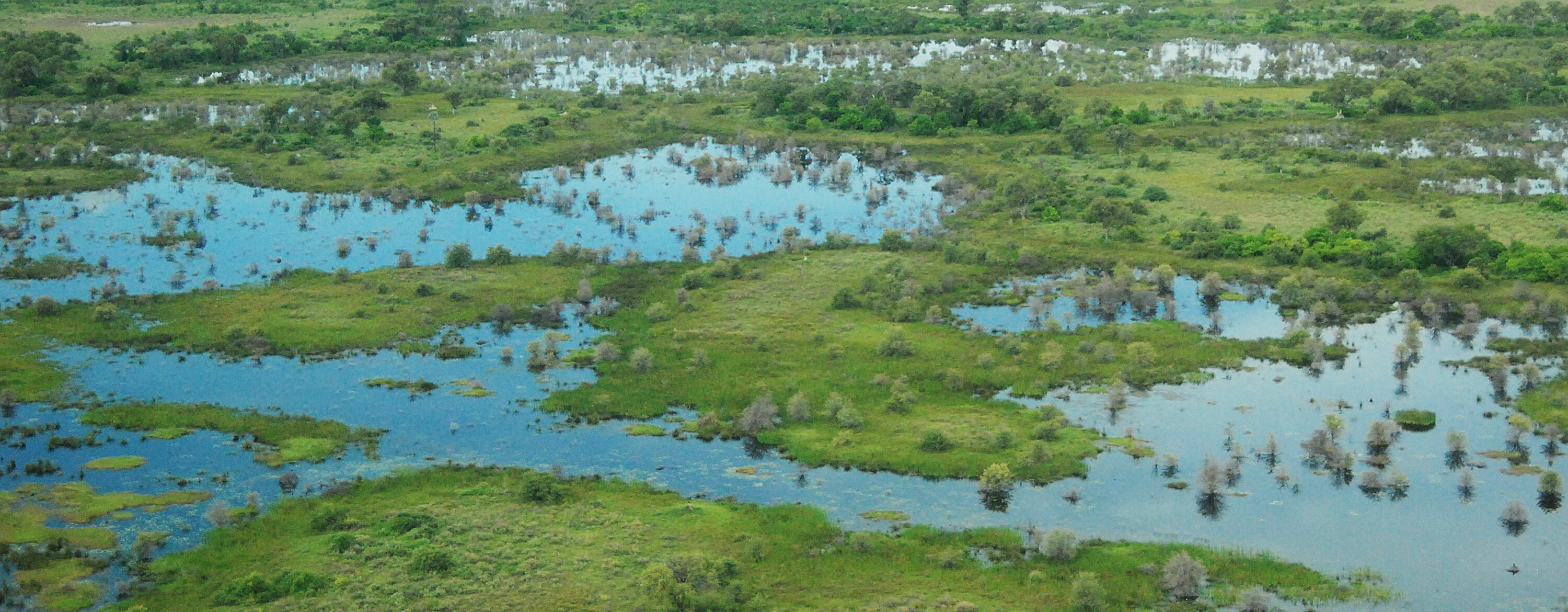 INDIA – The Mumbai Railway Vikas Corporation (MRVC) has hit a roadblock as its plan of enhancing the railway line capacity between Virar and Dahanu on the western line has been stagnated. The project was initially approved in February 2022; however, the Bombay High Court is yet to approve the project's clearing of 24.5 hectares of mangroves in the Palghar district. The Regional Empowered Committee (REC) of the Ministry of Environment, Forests and Climate Change has given permission to MRVC to start construction on the railway line's sections that are not within protected mangrove patches, although Stage II's final approval is still pending. The project will result in the removal of roughly 25 thousand trees, about 24 thousand of which would be mangroves, therefore the improvement will come at a price to the ecosystem. On 54 hectares of degraded land in three surrounding villages in Palghar itself, compensatory afforestation will be recommended in order to lessen the effects of the loss of such natural resources. INDIA – The Mumbai Railway Vikas Corporation (MRVC) has hit a roadblock as its plan of enhancing the railway line capacity between Virar and Dahanu on the western line has been stagnated. The project was initially approved in February 2022; however, the Bombay High Court is yet to approve the project's clearing of 24.5 hectares of mangroves in the Palghar district. The Regional Empowered Committee (REC) of the Ministry of Environment, Forests and Climate Change has given permission to MRVC to start construction on the railway line's sections that are not within protected mangrove patches, although Stage II's final approval is still pending. The project will result in the removal of roughly 25 thousand trees, about 24 thousand of which would be mangroves, therefore the improvement will come at a price to the ecosystem. On 54 hectares of degraded land in three surrounding villages in Palghar itself, compensatory afforestation will be recommended in order to lessen the effects of the loss of such natural resources.Did Humans Arrive in Micronesia Much Earlier Than We Thought?
 MICRONESIA – Sea levels in Micronesia rose much faster over the past 5,000 years than previously thought, according to a new study published recently in Proceedings of the National Academy of Sciences. This sea level rise is shown by the accumulation of mangrove sediments on the islands of Pohnpei and Kosrae. The finding may change how we think about when people migrated into Remote Oceania, and where they might have voyaged from. The Study looks at the published ages of settlement across the western part of Remote Oceania and found that high islands tend to show earlier ages of settlement compared to atolls, which is what we would expect. But we don’t see this pattern in Micronesia: The high islands of Pohnpei and Kosrae show settlement ages about 1,000 years later than other similar islands. Why? Deep within the mangrove forests of Pohnpei and Kosrae, previous researchers found mangrove sediments up to five meters (16.4 feet) deep. The only explanation for such deep mangrove sediments is sustained sea level rise. Mangroves live at the coast, between low tide and high tide. Therefore, as sea level rises, organic carbon and sediments accumulate beneath the mangrove forests, creating deep soils. MICRONESIA – Sea levels in Micronesia rose much faster over the past 5,000 years than previously thought, according to a new study published recently in Proceedings of the National Academy of Sciences. This sea level rise is shown by the accumulation of mangrove sediments on the islands of Pohnpei and Kosrae. The finding may change how we think about when people migrated into Remote Oceania, and where they might have voyaged from. The Study looks at the published ages of settlement across the western part of Remote Oceania and found that high islands tend to show earlier ages of settlement compared to atolls, which is what we would expect. But we don’t see this pattern in Micronesia: The high islands of Pohnpei and Kosrae show settlement ages about 1,000 years later than other similar islands. Why? Deep within the mangrove forests of Pohnpei and Kosrae, previous researchers found mangrove sediments up to five meters (16.4 feet) deep. The only explanation for such deep mangrove sediments is sustained sea level rise. Mangroves live at the coast, between low tide and high tide. Therefore, as sea level rises, organic carbon and sediments accumulate beneath the mangrove forests, creating deep soils.Like this newsletter? *Articles in this newsletter may mention practices being used and/or show exagerated results being claimed without proof. Stories are presented here in effort to show mangrove related activity around the world and do not necessarily reflect Mangrove Action Project's views or mangrove restoration best-practices. NOTICEChildrens Art Calendars 2023
ORDER YOURS HERE
ACTION ALERTS
|
|
|
Mangrove Action Project Click here to view past newsletters
|
|
-
The community of adults and youth in Cayman Islands has come together recently to release a series of educational videos. Each is geared to...
-
By Alfredo Quarto, Program & Policy Director Co-founder, MAP There is a rather urgent situation concerning the bio-invasion of the Son...
-
By: Isabel Robinson, MAP Volunteer Intern Some months ago I decided to come to Thailand and do an internship in mangrove conservation, ...
MAP News Issue #596 = April 20, 2024
ENTRIES NOW OPEN! Mangrove Photography Awards 2024 10 Years Celebrating Mangroves GLOBAL - MAP has launched our 10th Mangrove Photograp...




